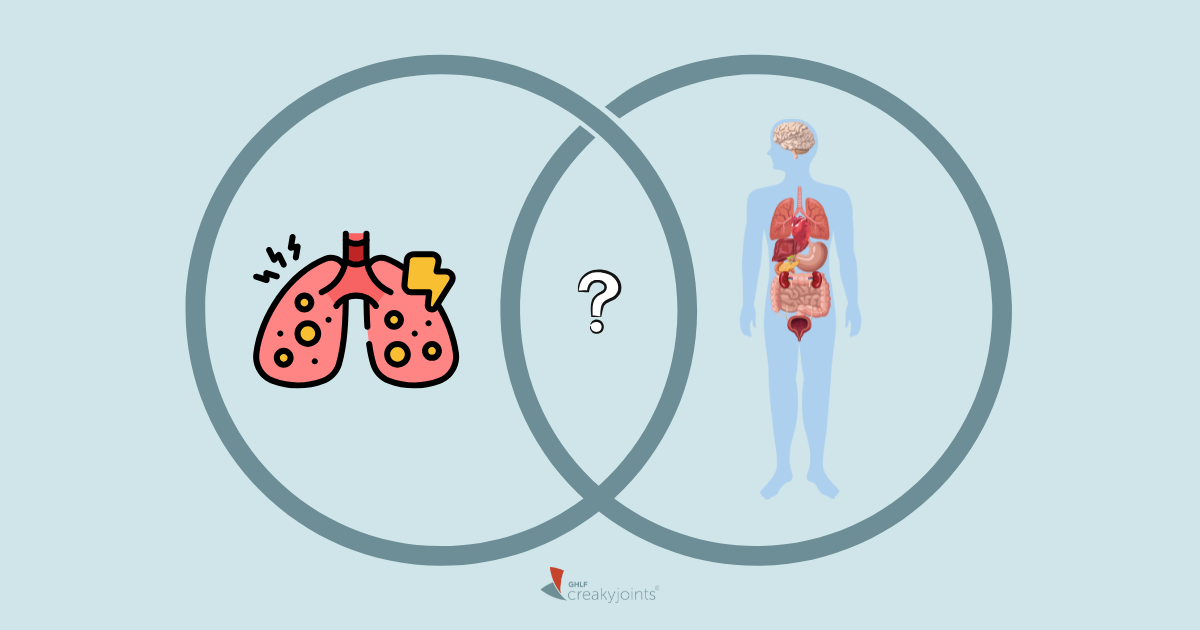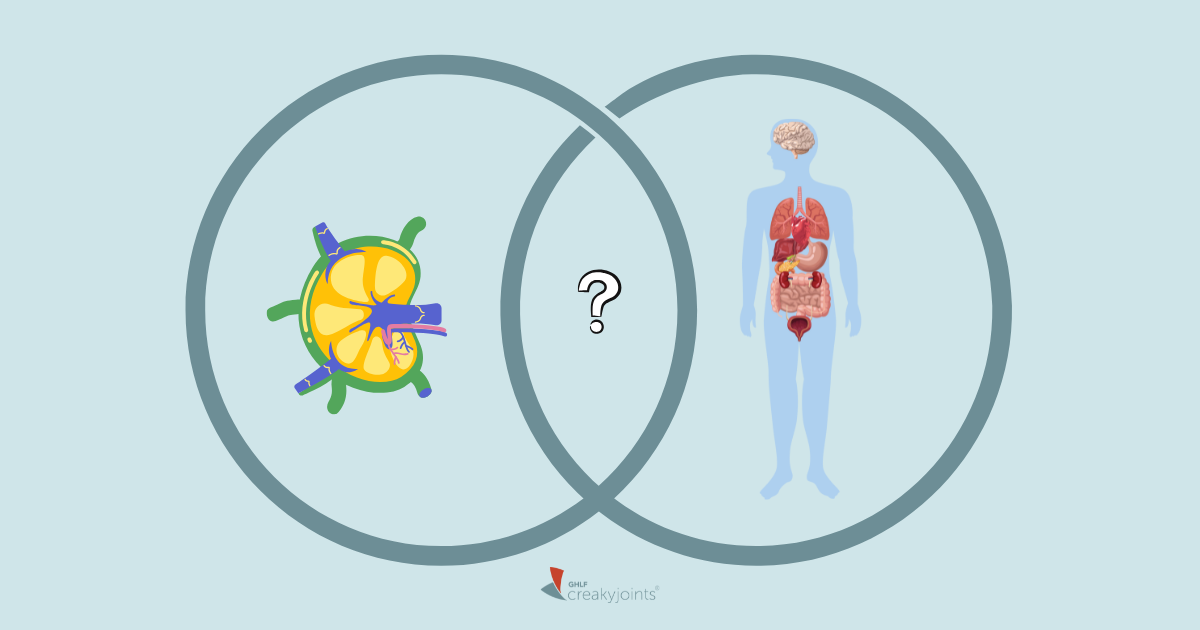

Living with psoriatic disease isn’t just a skin-deep issue; it affects you inside and out. Beyond the obvious symptoms like itchy skin and sore joints, the condition can take an emotional toll and even harm other organs like your heart and kidneys. About 30 percent of people with psoriasis also get psoriatic arthritis, which cause lasting damage if ignored.
A 2020 study highlighted how the inflammation from PsA doesn’t stop at the skin; it can also lead to kidney and heart issues, and worsen conditions like obesity. That’s why it’s crucial to keep an open line with your doctor, addressing not just the symptoms you can see, but also the hidden impacts on your well-being.
To get an inside look at living with this complex disease, we talked to Ashley Krivohlavek, who’s been managing both psoriasis and psoriatic arthritis for years. Here, she shares tips on tackling the visible and invisible challenges of this chronic condition.
Skin and Nail Issues
A 2022 study published in the International Journal of Rheumatic Diseases reported that almost 60 percent of people with PsA show signs of nail psoriasis. Those with nail psoriasis had more swelling, tender joints, and skin disease severity. They also experienced greater invisible symptoms, such as pain and fatigue.
Fingernails and toenails can be affected, causing pitting, ridging, abnormal nail growth, and discoloration. The nails may loosen and separate from the nail bed, or in some cases crumble.
Topical steroids and vitamin-D based therapies are the main treatments for nail psoriasis. Biologics and retinoids are also available.
Patient Tip: To help with the changes to her nails, Krivohlavek says giving herself or getting regular manicures has helped her tremendously. For skin, keeping up with the topical medicine, using moisturizers, and sunscreen has been important. But what has helped her the most? Confidence. “You have to know that the symptoms are not you,” she says.
Joint Pain and Stiffness
Psoriatic arthritis can affect the small joints in the fingers and toes and it can also be in the hands, knees, ankles and feet, and in some cases, the lower back.
Depending on the severity of your PSA, your provider may prescribe:
Mild PsA:
- Nonsteroidal anti-inflammatory drugs (NSAIDs)
- Glucocorticoid injections
- Disease-modifying antirheumatic drugs (DMARDs), such as methotrexate, sulfasalazine, or another DMARD, depending on which joints or areas of your body are affected
Moderate to Severe PsA:
- Methotrexate or other DMARDs
- Tumor necrosis factor inhibitors (TNFi drugs)
- Interleukin 12/23 inhibitors (IL12/23i drugs)
- Interleukin 17 inhibitors (IL17i drugs)
- CTLA4-Ig drugs
- Janus kinase inhibitors (JAK inhibitor drugs)
- Other drugs as determined by your health care professional
There is no one-size-fits-all approach to PsA treatment. Your doctor will come up with a plan that is just right for you.
Patient Tip: “I subscribe to ‘motion is lotion,’” says Krivohlavek. “Even if you are not moving a whole lot, moving some is so critical — just don’t overdo it.” Research backs this up: A 2021 study in the journal Clinical Rheumatology found that the majority of patients who exercised had lower disease activity and also experienced improvement with pain and fatigue.
Fatigue and Low Energy
Psoriatic disease can cause fatigue — a symptom that is often overlooked by health care providers. In PsA, fatigue is connected to the length of disease, severity of the skin plaques, and number of joints affected.
Some of the medications that treat psoriatic disease can cause fatigue. Fatigue can also be the result of poor sleep when psoriasis plaques cause pain and itchiness. It can also strike when you are struggling emotionally.
Severe fatigue affects 28 percent of patients with PsA and 17 percent of those with plaque psoriasis, causing reduced quality of life, according to a 2020 paper published in Advances in Dermatology and Allergology.
Fatigue can cause other invisible symptoms as it pulls you away from life activities and impacts your quality of life. As a result of fatigue, patients can experience social isolation and job loss, according to the paper. A 2021 study has shown that fatigue is strongly associated with disease activity and functional impairment.
Patient Tip: Often your fatigue is telling you that you need to slow down. It can be hard to accept a lower level of productivity for yourself, but it may be what your body needs, even if it’s temporarily. “The best thing to do is rest as much as you can and just take things a chunk at a time, knowing you are never going to complete your to do list,” says Krivohlavek. “You have to be ok with that. It’s a mindset.”
Depression and Anxiety
When dealing with psoriatic disease, you may have emotional issues, such as anxiety and depression, that may stem from issues of stigmatization, says Joel Gelfand, MD, MSCE, FAAD, a dermatologist and Professor of Dermatology and Epidemiology at Penn Medicine in Philadelphia.
Sometimes, just treating the physical symptoms can have an impact on the invisible ones. “Often, when we successfully treat the skin and joints, the emotions can improve,” he says. But it’s important to know what’s going on with your body, so you can get the proper treatment and start feeling better, inside and out.
A 2022 global survey involving 1,286 PsA patients across eight countries revealed the disease’s widespread impact. While nearly all participants reported muscle and joint issues, and 80 percent had skin or nail problems, the mental health toll was significant. About 69 percent said their emotional well-being was moderately or severely affected, 56 percent saw an impact on romantic relationships, and 44 percent felt it strained friendships and family ties.
Participants also noted feelings of emotional distress, social shame, unusual fatigue, and a tendency to withdraw from social activities.
Mina Guirguis, Founder of the Emotional Wellness Center for Skin Disorders and a licensed clinical psychodermatologist, says he sees many patients with symptoms of depression and anxiety, which can stem from negative thoughts about your skin condition.
“These thoughts often keep swirling around in the mind and are a source of emotional discomfort,” he says. Examples include thoughts like “Why is this happening to me?” or “People will reject me because of how I look.”
In extreme cases, these thoughts can lead to suicidal ideation. Dr. Guirguis notes that recognizing the difference between short-term sadness and clinical depression is crucial. “Clinical depression is feeling sad for most of the day for at least two weeks and the person will experience symptoms like social isolation, increased sleeping or sleeping disturbances, difficulty concentrating and at times suicidal [thoughts],” says Dr. Guirguis.
If you have any of these thoughts, reach out to your health care provider to get the help you need.
Patient Tip: Krivohlavek knows how hard it can be sometimes. “When you are in that moment, it’s important to remember that things are temporary,” she says. She recommends trying to do things that spark joy, even if it’s lighting a candle, texting a friend, or reading a book. “Small joys add up over time,” she says.
Sleep
Almost 70 percent of patients with PsA and 60 percent of those with psoriasis experience poor sleep quality. Some of the reasons are increased pain, itching, higher levels of inflammation, anxiety, depression, adverse reactions to medications and even intense fatigue, according to a study in the journal Reumatologia.
Certain sleep disorders are also common among patients with psoriatic disease. These include obstructive sleep apnea and restless leg syndrome.
Patient Tip: While there can be many causes to sleep issues, Krivohlavek says it’s important to keep a consistent bedtime routine. “Go to bed at the same time every night, do whatever your rituals are, whether it’s reading an hour or something else that makes you calm down,” she says. And get up at the same time every day. Keeping to a daily sleep routine can help you get better sleep, she says.
Social Stigma
The visible symptoms of psoriatic disease can cause the invisible symptoms of shame and embarrassment. Dr. Guirguis says a person with psoriatic disease can experience worry over self image. “We see patients who tend to isolate or hide their skin condition and will worry about how others perceive them,” he says.
Dr. Guirguis says the bottom line is acceptance. He says when someone changes from hiding their skin condition to accepting it, self image and confidence rise. Working with a qualified mental health therapist, especially one who works with patients with skin conditions, can help you effectively deal with negative beliefs and thoughts.
Patient Tip: Knowing your self worth is extremely important, Krivohlavek says. “You have to have a strong personality to let it roll off of you when people stare at your psoriasis. The good news is that it’s as simple as ignoring other people’s reactions,” she says.
Brain Fog
There is still not enough research to connect psoriatic arthritis and cognitive impairment, but some researchers believe that the proteins called cytokines, which are released by the immune system, can send signals to your brain and get in the way of normal cognitive functioning. Inflammation may also contribute to brain fog.
Forgetfulness, losing your train of thought, and difficulty concentrating are the main signs of brain fog.
Patient Tip: Krivohlavek has had a constant struggle with brain fog, she says. Her advice? Make lists. “I write everything down. It helps me to remember.”
Working With Your Health Care Provider To Manage Your Symptoms
The physical symptoms of psoriasis and psoriatic arthritis can make life challenging. But keeping your doctor advised of all your symptoms — visible and invisible — will enhance and maximize your treatment.
Dr. Guirguis adds: “Acceptance of one’s condition does not mean a patient should give up on seeking treatment. Acceptance of one’s condition and situation will help a patient free their mind of worrying how others will perceive them.”
Be a More Proactive Patient with ArthritisPower
ArthritisPower is a patient-led, patient-centered research registry for joint, bone, and inflammatory skin conditions. You can participate in voluntary research studies about your health conditions and use the app to track your symptoms, disease activity, and medications — and share with your doctor. Learn more and sign up here.
Interview with Joel Gelfand, MD, MSCE, FAAD, a dermatologist and Professor of Epidemiology at Penn Medicine in Philadelphia
Adebajo A, et al. Patient educational needs and challenges in psoriatic arthritis. Current Opinion in Rheumatology. July 1, 2021. doi: https://doi.org/10.1097/bor.0000000000000801.
Chia A, et al. Managing psoriatic arthritis with inflammatory bowel disease and/or uveitis. Frontiers in Medicine. September 16, 2021. doi: https://doi.org/10.3389/fmed.2021.737256.
Davies K, et al. Fatigue in inflammatory rheumatic disease: current knowledge and areas for future research. Nature Reviews Rheumatology. November 2021. doi: https://doi.org/10.1038/s41584-021-00692-1.
Krivohlavek A, Please hear me: How effective provider-patient communication improved my psoriatic arthritis. American College of Rheumatology Meeting Abstracts. November 12, 2022. https://acrabstracts.org/abstract/please-hear-me-how-effective-provider-patient-communication-improved-my-psoriatic-arthritis/
Queiro R, et al. Non-physical disease facets in spondyloarthritis: An ASAS health index-based analysis between psoriatic arthritis and axial spondyloarthritis. Journal of Clinical Medicine. October 16, 2022. doi: https://doi.org/10.3390/jcm11206094.
Skougaard M, et al. In Psoriatic Arthritis fatigue is driven by inflammation, disease duration, and chronic pain: An observational DANBIO registry study. The Journal of Rheumatology. July 2019. doi: https://doi.org/10.3899/jrheum.181412.
.





